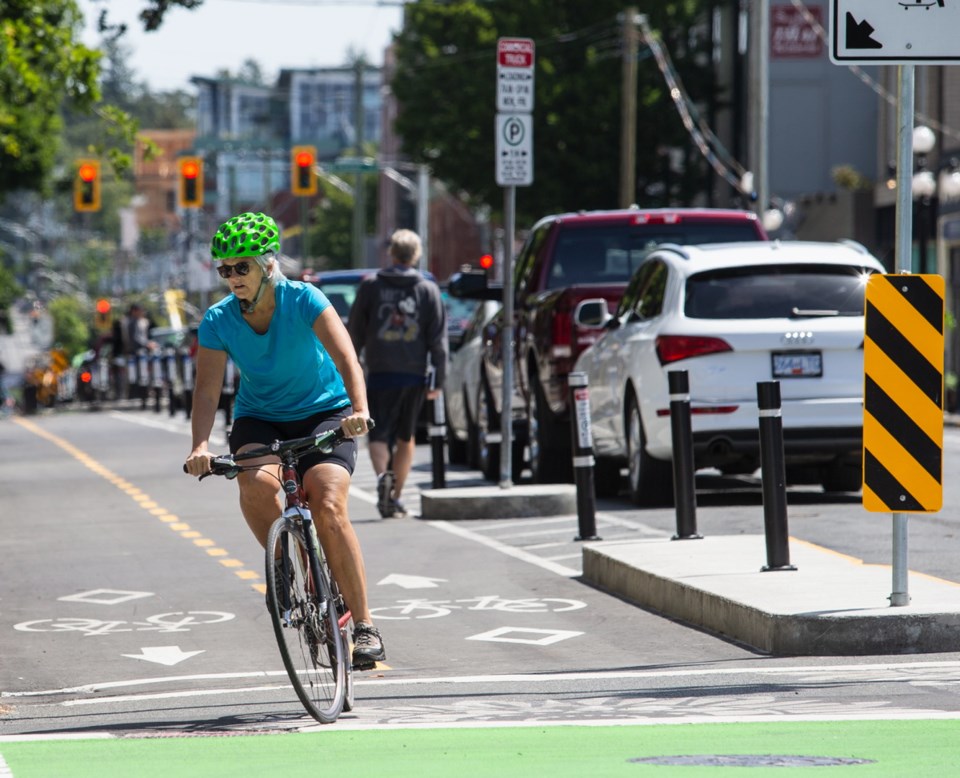I am a lifelong, avid cyclist, and for the past 15-plus years, I’ve had the good fortune to be able to cycle from my home on the Gorge to my workplace on Dallas Road in all seasons — for which I am truly grateful.
However, I am also a driver, and like most of us, depend upon a car to negotiate the necessities and desires that daily life presents. It is from that perspective that I offer this evaluation of the bike-lane controversy that has provoked such debate in our city.
The attempt to create a little biking utopia in downtown Victoria has been a costly mistake. Put simply, the numbers are nowhere near sufficient to justify the disruptive effects of the changes. I’ve heard estimates of 10 to 15 per cent of commuters being cyclists, but I suspect that whoever came up with that figure was the same person who counted the inauguration crowds for U.S. President Donald Trump.
Sure, there is a steady stream of bike traffic for about 90 minutes each morning — but it’s measured in dozens, not hundreds. Ten per cent would require thousands. And after that brief morning surge, the lanes sit almost vacant for six or seven hours until the afternoon exodus takes place.
One lovely weekday morning in early summer, I was driving west on Pandora Avenue about 9:30. From Cook to Wharf streets, I counted four bikes in the lane. Later that day, headed south on Government Street, I watched as several cars were stopped on Pandora, unable to turn right, while zero bikes made use of the bike-lane advance light.
On a more recent beautiful morning, about 10 a.m., I rode my bike east in the Pandora lane from the new bridge. There was a dribble of bike traffic as far as Government Street, but beyond that there were no more than one or two bikes per block as far as Cook.
That’s a lot of money and inconvenience for very little return.
There are some actual numbers to help form a realistic analysis. The Times Colonist recently printed the city’s count of 530,000 bike trips in the first 14 months of lane operation. A quick back-of-napkin calculation shows that comes to about 1,300 rides per day. Assuming each rider must return from where she set out, that equals about 650 riders using the lanes daily.
If you were to be ridiculously optimistic and suppose that the lanes could produce a 50 per cent increase in ridership, that would bring you to about a thousand riders a day. That’s a nice number, but it’s still trivial compared to the volume of vehicle traffic. And let’s be realistic: Most drivers couldn’t switch to cycling even if they wanted to, for a wide range of completely legitimate reasons.
In the same article that produced the bike-lane numbers, Mayor Lisa Helps was quoted rhapsodizing on “validation,” “future-proofing the city” and “taking action on climate change.” I’m pretty sure that spending $7 million on bike lanes has about as much effect on climate change as outlawing plastic straws has on the condition of the ocean.
This leads me to the conclusion that bike lanes, like plastic-straw prohibition — and tearing down statues, for that matter — is a vanity project. It’s meant to allow its proponents to feel good about themselves, to show they are fighting the good fight — no matter how useless the actual effects of their efforts.
And what are those effects? Well, there’s the $7-million — and counting — outlay for lanes themselves. Then there’s the considerable inconvenience to all those adversely affected, from drivers to merchants to homeowners, just to name the most obvious. Nor should the disregard for those affected go unmentioned.
In fact, disregard might be too weak a word. There has been, throughout this process, an air of disdain for those opposed, as if their real-world concerns were trivial in comparison to the big pictures such as climate change. Once again, very like the attitude toward those who opposed the removal of the statue of Sir John A. Macdonald.
The whole exercise has been a case of the Nanny State stretched to its logical conclusion. And it’s not the Nanny State of: “A spoonful of sugar helps the medicine go down.” It’s the Nanny State of: “It’s good for you, no matter how bad it tastes, so open wide.”
The Victoria region is and will remain a wonderful venue for cyclists, for which I am truly grateful. But the money and inconvenience that the new bike lanes have cost is greatly out of proportion to the present level of use, or any that can be reasonably expected any time soon.
There are certainly many more worthy areas for the city to spend its energy and tax dollars. That is a message that the citizens of Victoria should send to their officials as soon as possible.
Michel Murray lives in Victoria.



